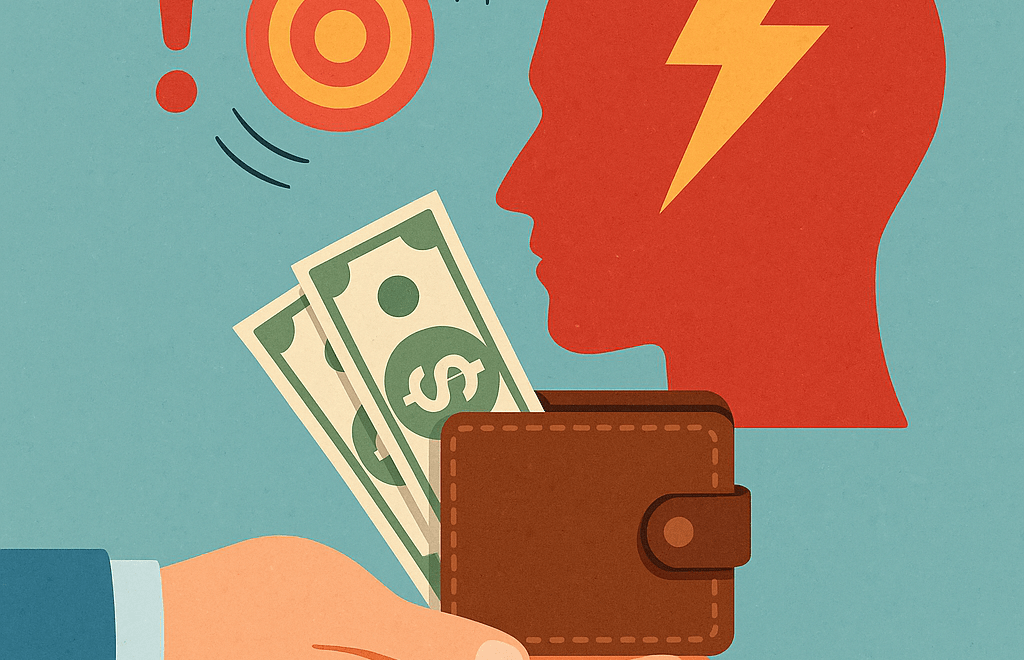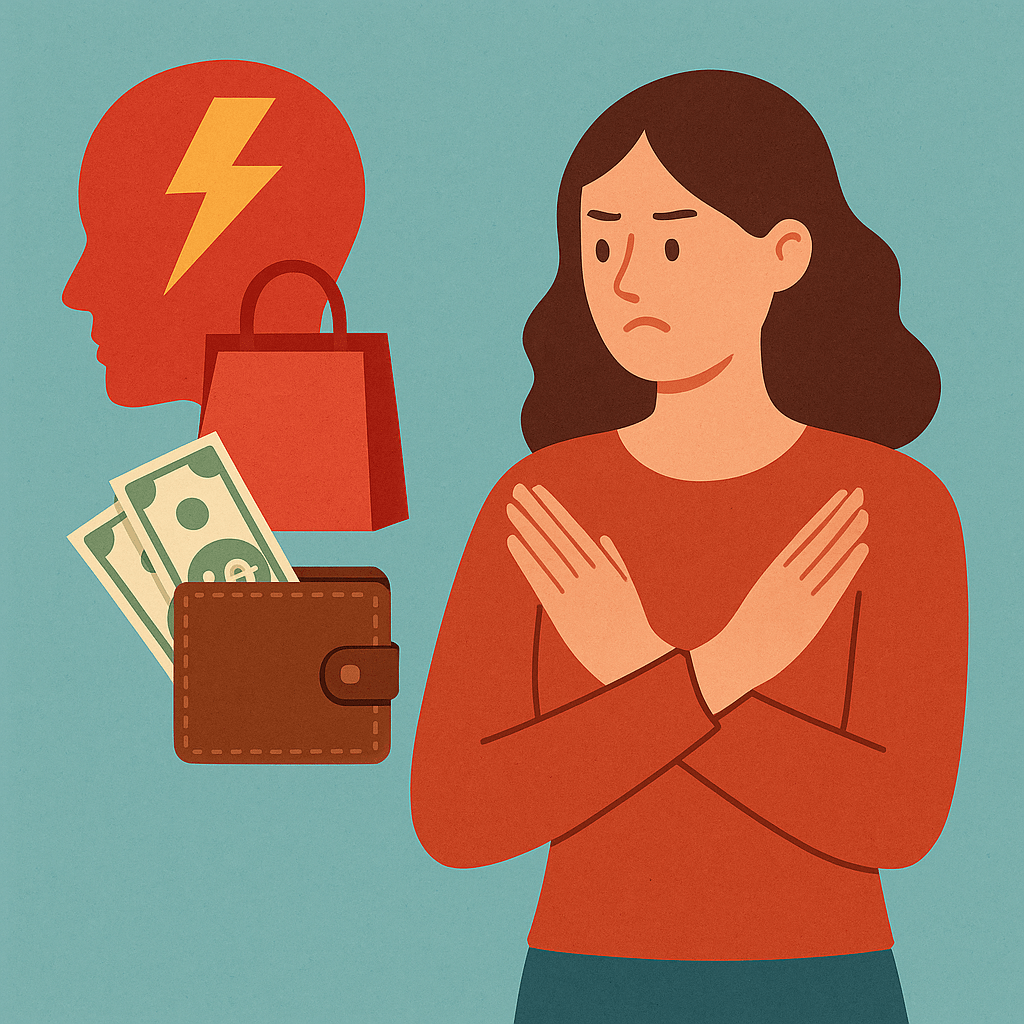
Do you ever ask yourself, “Why do I keep spending money on things I don’t even need?” You’re not alone — and the answer may lie in spending triggers: subconscious cues that hijack your decision-making and lead to emotional or impulsive purchases.
In this guide, we’ll break down:
- What spending triggers are
- The different types of triggers
- How your brain and dopamine play a role
- Rewiring techniques to take back control
- Tools to support healthier habits
This article is ideal for anyone looking to improve their relationship with money, reduce emotional spending, and build better financial habits.
✅ What Is a Spending Trigger?
A spending trigger is any emotional, psychological, or environmental cue that prompts the urge to spend — often without conscious thought.
These triggers bypass logic and tap into dopamine-fuelled reward systems in your brain. They often feel good in the moment, but lead to regret later. Marketing experts know this well and design environments that activate these behaviours.
🧠 Did You Know?
Dopamine is a neurotransmitter linked to pleasure and motivation. Shopping — especially online — delivers an instant dopamine hit, reinforcing the behaviour. This is why one-click buying and “buy now, pay later” schemes feel addictive.
📊 Why This Matters: The UK Spending Problem
- According to Statista (2024), the average UK household spent £528.80 per week on consumption.
- A 2023 study by the Money and Mental Health Policy Institute found that 72% of people with mental health issues have made impulsive purchases they later regretted.
- Over 8 million UK adults are estimated to be in problem debt, partly fuelled by uncontrolled spending habits.
Common Types of Spending Triggers
Recognising your unique triggers is the first step to breaking the habit loop. Here are the most common types of spending triggers:
1. Emotional Triggers
Stress, sadness, loneliness, boredom — these emotions often lead to “comfort spending.”
💬 “I was feeling down, so I treated myself.”
2. Social Pressure
You feel compelled to spend because friends, colleagues, or influencers are doing it, and feel pressure to keep up.
💬 “Everyone’s going on holiday – I don’t want to be left out.”
3. Sales, Scarcity & FOMO
The classic “50% off!” deal or “Only 2 left in stock!” creates a sense of urgency, triggering fear of missing out (FOMO) and leading to purchases you didn’t plan.
💬 “It was such a good deal – I couldn’t pass it up.”
4. Advertising and Influencer Content
Instagram ads or TikTok hauls subtly convince you that you need the latest product, even if you didn’t want it five minutes ago.
5. Environmental Triggers
Places and routines can cue spending. Think: walking past your favourite coffee shop or browsing ASOS during lunch.
💬 “I always end up buying something when I’m bored at work.”
6. Instant Gratification
Online shopping, food delivery apps, and tap-to-pay systems remove friction. You don’t feel the cost — until later.
💬 “It was just one click.”
🧠 Signs You’ve Been Triggered
How can you tell when you’re operating on impulse? Look out for these signs:
| 🚨 Trigger Sign | 🛠 What To Do |
|---|---|
| Sudden urge to “treat yourself” | Pause for 5 minutes |
| Spending late at night or when tired | Try the HALT check (see below) |
| Feeling guilty immediately after buying | Reflect and journal the emotion |
| Rationalising the purchase (“I deserve this”) | Ask: “Would I buy this again tomorrow?” |
🚨 How to Recognise Your Spending Triggers

Awareness is key. Here’s how to spot your own patterns:
✍️ 1. Keep a Spending Journal
Write down every purchase you make for at least a week — including how you felt before and after. Over time, patterns will emerge.
🧩 2. Track Emotions, Not Just Expenses
Use a mood tracker app (like Daylio or a simple notebook) to connect your spending to your emotional states.
🔄 3. Identify “Hot Spots”
Note where and when you’re most likely to overspend — e.g., late-night online shopping, scrolling after work, or shopping when you’re tired.
🔁 How to Rewire Your Spending Triggers
Recognising is only half the battle. The next step is rewiring your response. Here’s how:
🛑 1. Use the HALT Technique
Before spending, ask: Am I Hungry, Angry, Lonely, or Tired?
These states reduce self-control and increase emotional buying.
🎯 2. Define “Anti-Goals”
Instead of only setting goals like “save more,” define what you won’t spend on:
- “No takeaway coffees for 30 days”
- “No Amazon purchases this month”
This builds awareness and limits mindless buying.
⏳ 3. Try the 1% Rule
Pause on any purchase over 1% of your monthly income (e.g., £25 if you earn £2,500) and revisit it after 24–48 hours.
🔐 4. Create Friction
Make spending inconvenient:
- Remove saved cards from browsers
- Log out of shopping apps
- Use prepaid debit cards
- Use a 24-hour rule for online purchases.
- Unsubscribe from marketing emails.
🔄 5. Replace the Habit
When the urge strikes:
- Journal your feelings
- Go for a walk
- Message a friend
- Do 5 minutes of deep breathing
🎯 6. Reconnect to Your Why
Create visual goals: a savings tracker, dream house, or debt-free countdown. Keep them visible.
When your why is strong enough, your spending habits start to change. Set short-term goals like “Save £500 in 3 months” or long-term ones like “Buy a house deposit.”
Use tools like MoneyHelper from the UK Government to create a tailored savings plan.
🧰 Rewiring Toolbox
| Trigger Type | Rewire Tactic |
|---|---|
| Emotional (e.g. stress) | HALT, journal, walk, call a friend |
| Social comparison | Unfollow triggering accounts, use gratitude journaling |
| Instant gratification | Install spending blocker apps (e.g., Snoop, Plum) |
| Sales/FOMO | Use the 1% rule and unsubscribe from promo emails |
| Environmental | Change routine, take different routes, avoid “hot zones” |
📚 UK-Specific Tools & Resources
- MoneyHelper – Free budgeting planners and savings calculators
- NHS Mind Plan – Tools for stress and anxiety
- Mind UK – Mental health support
- StepChange – Free UK debt advice and support
💡 Real-Life Example
“I used to impulse buy every time I felt anxious at work. Once I started tracking my spending and noticing the link, I created a ‘pause jar.’ Every time I resisted a buy, I put £2 in. Three months later, I had £120 saved — and way more control.” – Claire, 32, Manchester
📌 Key Takeaways
- A spending trigger is an emotional or environmental cue that prompts impulsive spending.
- Triggers include emotions, social pressure, advertising, scarcity, and instant gratification.
- You can rewire habits using tools like HALT, the 1% rule, and anti-goals.
- UK tools like MoneyHelper and StepChange offer tailored support.
❓ Frequently Asked Questions
🤔 How do I stop emotional spending?
Start by tracking your mood before spending. Use the HALT method to check if your emotions are influencing your decisions. Then, replace the urge with healthier coping strategies.
🧠 What is the HALT technique?
HALT stands for Hungry, Angry, Lonely, or Tired — four emotional states that increase impulsive behaviour. Check in with yourself before you spend.
💳 Can I train myself out of impulse buys?
Yes. By increasing awareness, introducing friction, and building better habits (like journaling or the 1% pause rule), you can retrain your brain to delay gratification.
📲 What UK tools can help me budget?
Start with MoneyHelper’s budget planner, Snoop, or Plum. For debt support, StepChange is free and confidential.
*The article above includes general information and should not be taken as financial advice.





